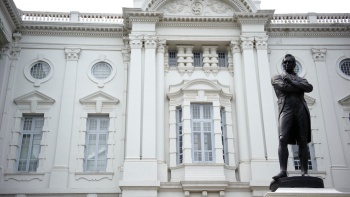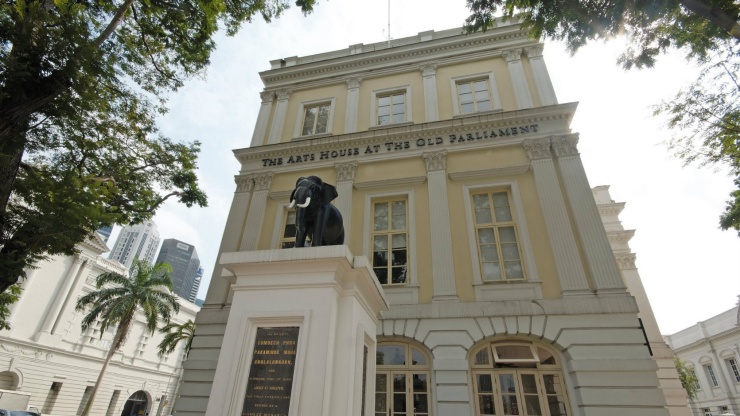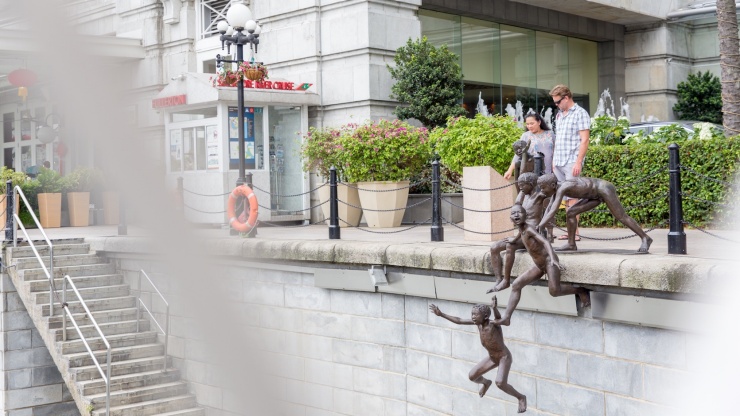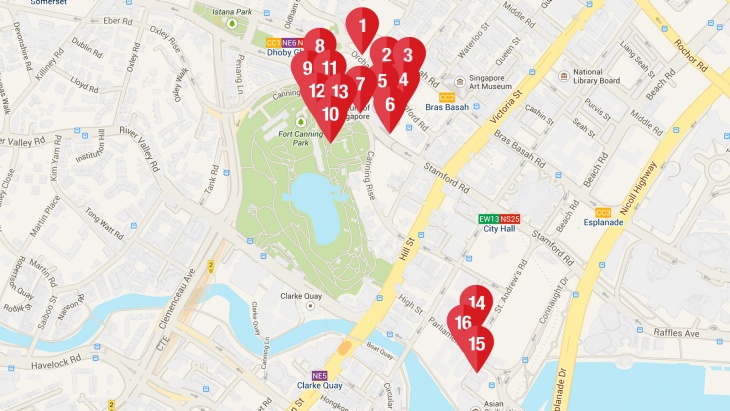Travel back into the colonial era on the Civic District Art Trail, and learn about some of Singapore’s significant monuments and memorials.
A peek into Singapore’s heritage through art
If you’re interested to know more about the country’s history and its art, this is the guide for you.
The Civic District Art Trail dives into the heart of the city’s past, with monuments commemorating prominent historical figures such as Sir Stamford Raffles, historical monuments and architectural icons of the 21st century.
You’ll also get to admire the works of some of Singapore’s pioneering sculptors, as well as modern pieces by artists from around the globe.
Dhoby Ghaut MRT station to the National Museum of Singapore
Alight at Dhoby Ghaut MRT station and head towards the National Museum of Singapore. On your walk, you’ll come to an angular structure on a grassy patch just in front of the YMCA of Singapore, at the corner of Prinsep Street and Orchard Road. This is 1 Endless Flow (1980), the second public sculpture by Singaporean artist Tan Teng Kee.
Commissioned by OCBC Bank, this 6.4-metre-high brass sculpture was originally installed outside the OCBC Centre on Chulia Street. After the bank donated it to the Parks and Recreation Department in 1983, it was moved to Bras Basah Park and later to its current location.
When you get to the National Museum of Singapore, you’ll notice 2 20 Tonnes (2002) by Singaporean sculptor Han Sai Por–six rough, ridged granite slabs lined up in a row. Another of Han’s artworks is 3 Seeds (2006), two giant brown kernels carved from sandstone excavated from Fort Canning Park while the museum was being developed.
Towards the left, you’ll see 4 Living World (1987), four colourful bronze figures by Taiwanese sculptor Ju Ming for the centennial celebrations of the then Singapore National Museum. At the side sits the spiky, twisting stainless steel sculpture, 5 Transformation (2004) by famed sculptor Tan Teng Kee.
Just a few steps outside the National Museum is 6 Let There Be Peace (2005) by Alexandra Nechita from Romania, a three-metre-tall bronze United Nations Peace Monument for Asia. Walk towards the museum's back entrance. Here, you’ll see 7 Pedas Pedas (2006) by Singaporean artist Kumari Nahappan. The title means ‘spicy’ in Malay, and this giant chilli pepper sculpture symbolises Singapore’s rich blend of cultures.
ASEAN Sculpture Garden
Crossing the road from the National Museum of Singapore at Fort Canning Link, you’ll get to Fort Canning Park. Walk past the carpark and you’ll get to the ASEAN Sculpture Garden.
The outdoor artworks at this quiet spot were created in 1981 for the ASEAN Sculptures Symposium in Singapore. Each of the five founding member countries of the Association of Southeast Asian Nations–the Philippines, Thailand, Indonesia, Malaysia and Singapore–donated a sculpture to this garden within a park. In 1988, Brunei contributed its piece when it became an ASEAN member.
The bold, red 8 Augury (1988) by Malaysian Anthony Lau was a replacement after the original fibreglass sculpture Taming Sari by Ariffin Mohammed Ismail could not withstand the weather.
Known as the grandfather of Singapore sculpture, Ng Eng Teng created the minimalist 9 Balance (1982), which was commissioned by the Committee on Culture and Information.
10 Concentration (1982), by Vichai Sithiratn from Thailand, is made up of steel plates while 11 Unity (1982) by Indonesian sculptor But Muchtar is made of copper and steel.
The flagpole-like, stainless steel 12 Together (1988) is by Brunei’s Osman Bin Mohammad and symbolises the six members of ASEAN at the time.
Finally, the five-metre-tall steel-and-concrete 13 Fredesvinda (1982) by Napoleon Veloso Abueva from the Philippines resembles the skeleton of an unfinished boat. The title means ‘strength of the country’ in German.
City Hall MRT Station to The Arts House

Take the train from Dhoby Ghaut MRT station and alight at City Hall MRT station. This is the heart of Singapore’s Civic District, with its many historic buildings.
Walk to the magnificent Old Supreme Court along St Andrew’s Road. This building is now a part of the National Gallery Singapore. You can still glimpse the 14 Allegory of Justice (1937) if you look up towards its roof. Representing a system where law and order prevail–with the figures of Justice, Mercy, the Law, Gratitude and Prosperity–this imposing piece was carved by Italian sculptor Cavalieri Rudolfo Nolli, who also worked on the new throne building for King Chulalongkorn of Siam in 1913.
Cross the street to Victoria Theatre. This is where you will see the likeness of the man who started it all, 15 Sir Stamford Raffles, the founder of modern Singapore. This is the original statue in blackened bronze, which was sculpted by Thomas Woolner in 1887, and its nickname orang besi means ‘iron man’ in Malay. It was originally installed on Queen Victoria's Golden Jubilee Day on 27 June 1887 at the Padang but was moved to its current location during Singapore’s Centenary Celebrations on 6 February 1919.
A short stroll away to The Arts House, formerly the old Parliament House, you’ll see the bronze 16 Elephant Statue. It was a gift by King Chulalongkorn to mark his 1871 visit. On its high pedestal, the monument’s inscription in Siamese, Jawi, Chinese, and English reads: “His Majesty Somdetch Paramindr Maha Chulalongkorn, the Supreme King of Siam, landed at Singapore, the first foreign land visited by a Siamese Monarch, on the 16th March, 1871.”


